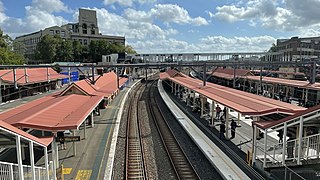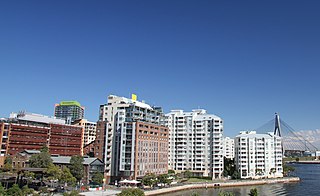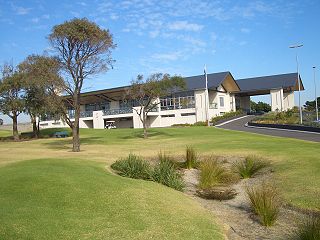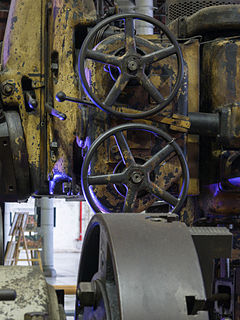
Waterloo is an inner-city suburb of Sydney, New South Wales, Australia. Waterloo is located 3 kilometres (1.87 mi) south of the Sydney central business district and is part of the local government area of the City of Sydney. Waterloo is surrounded by the suburbs of Redfern and Darlington to the north, Eveleigh and Alexandria to the west, Rosebery to the south, and Moore Park, Zetland, and Kensington to the east.

Redfern is an inner-city suburb of Sydney located 3 kilometres south of the Sydney central business district and is part of the local government area of the City of Sydney. Strawberry Hills is a locality on the border with Surry Hills. The area experienced the process of gentrification and is subject to extensive redevelopment plans by the state government, to increase the population and reduce the concentration of poverty in the suburb and neighbouring Waterloo.

Central is a heritage-listed railway station located in the centre of Sydney, New South Wales, Australia. The station is the largest and busiest railway station in Australia and serves as a major transport interchange for NSW TrainLink inter-city rail services, Sydney Trains commuter rail services, Sydney light rail services, bus services, and private coach transport services. The station is also known as Sydney Terminal. The property was added to the New South Wales State Heritage Register on 2 April 1999. It recorded 85.4 million passenger movements in 2018.

Darlington is a small, inner-city suburb of Sydney, in the state of New South Wales, Australia. Darlington is located about 3 kilometres south of the Sydney central business district and is part of the local government area of the City of Sydney. At the time of its incorporation in 1864, it had the distinction of being the smallest municipality in the Sydney metropolitan area, at a mere 44 acres. Darlington is bordered by City Road, Cleveland Street, Golden Grove Street, Wilson Street and Abercrombie Street.

Redfern railway station is a heritage-listed former railway bridge and now railway station located on the Main Suburban railway line in the Inner City Sydney suburb of Redfern in the City of Sydney local government area of New South Wales, Australia. It was designed by John Whitton and built by Department of Railways. It is also known as Redfern Railway Station group and Tenterfield railway. The property was added to the New South Wales State Heritage Register on 2 April 1999.

Chippendale is a small inner-city suburb of Sydney, New South Wales, Australia on the southern edge of the Sydney central business district, in the local government area of the City of Sydney. Chippendale is located between Broadway to the north and Cleveland Street to the south, Sydney Central railway station to the east and the University of Sydney to the west.

Pyrmont is an inner-city suburb of Sydney, in the state of New South Wales, Australia 2 kilometres south-west of the Sydney central business district in the local government area of the City of Sydney. It is also part of the Darling Harbour region. As of 2011, it is Australia's most densely populated suburb.

Zetland is an inner-city area of Sydney, New South Wales, Australia 4 kilometres south of the Sydney central business district, in the local government area of the City of Sydney.
Broadmeadow is the geographic center of Newcastle city. Its main commercial hub is located at the "Nineways". In 2016, it had a population of approximately 1,600.

Eastlakes is a suburb of Sydney, in the state of New South Wales, Australia. Eastlakes is located 8 kilometres south of the Sydney central business district, in the local government area of the Bayside Council, Eastlakes is mostly residential with a shopping centre located at Evans Avenue. There is a new shopping centre being built across the road from the current shopping centre, when the new one is complete the current one will be redeveloped. Golf courses also take up part of the suburb.

Homebush West is a suburb in the Inner West of Sydney, in the state of New South Wales, Australia. Homebush West is located 13 kilometres west of the Sydney central business district, in the local government area of the Municipality of Strathfield, with a small unpopulated strip in the northwest in Cumberland Council. The suburb is commonly referred to as Flemington, even in official contexts. This was the old name of the suburb before the establishment of Sydney Markets in 1975. Subsequently, "Flemington" was confined to the area occupied by the markets, whereas the residential part of the suburb was renamed "Homebush West", after the suburb of Homebush immediately to the east. Both the railway station and various organisations and businesses in the suburb still carry the name "Flemington". Homebush Bay was formerly a separate suburbs to the north.

South Eveleigh, previously known as Australian Technology Park (ATP) is a retail, business centre and technology park on Gadigal land, 3 kilometres (1.9 mi) south of the Sydney central business district and 8 kilometres (5.0 mi) north of Sydney Airport. South Eveleigh borders Alexandria and Eveleigh. Eveleigh Railway Workshops emerged on the site in the 19th century and it was transformed into Australian Technology Park in 1995.

The Cardiff Locomotive Workshops is a rail yard and rolling stock facility located between Cockle Creek and Cardiff stations near Newcastle, on the Main North railway line in New South Wales, Australia.

The Eveleigh Railway Workshops is a heritage-listed former New South Wales Government Railways yards and railway workshops and now venue hire, public housing and technology park located at Great Southern and Western railway, Redfern, City of Sydney, New South Wales, Australia. It was designed by George Cowdery and built from 1882 to 1897 by George Fishburn. It is also known as Eveleigh Railway Yards, South Eveleigh Precinct; North Eveleigh; Macdonaldtown Gasworks; Macdonaldtown Triangle and also by the name of its current occupants, Carriageworks. The property is owned by the Transport Asset Holding Entity, an agency of the Government of New South Wales. It was added to the New South Wales State Heritage Register on 2 April 1999. The workshops are considered to have world heritage significance by curators of the Smithsonian Institution.
The Eveleigh Carriage Workshops were built by the New South Wales Government Railways in 1888 as a depot for its passenger carriage fleet. The workshops are located west of what is now Redfern station on the northern side of the Main Suburban railway line opposite the heritage-listed Eveleigh Railway Workshops.

Carriageworks is a multi-arts urban cultural precinct located at the former Eveleigh Railway Workshops in Redfern, Sydney, Australia. Carriageworks showcases contemporary art and performing arts, as well as being used for filming, festivals, fairs and commercial exhibitions. The largest such venue in Australia, it is a cultural facility of the NSW Government, and receives support from Create NSW and the Australian Government through the Australia Council for the Arts. The centre has commissioned new work by Australian and international artists, and has been home to eight theatre, dance and film companies, including Performance Space, Sydney Chamber Opera and Moogahlin Performing Arts, and a weekly farmers' market has operated there for many years.

The New South Wales Standard suburban carriage stock are a class of electric multiple units that were operated by the New South Wales Government Railways and its successors between 1926 and 1992. They served on the Sydney suburban network. In the years before their withdrawal, they were nicknamed Red Rattlers.This term was imported from Victoria and was never a comtemporaneous colloquialism.

The Eveleigh Chief Mechanical Engineers office is a heritage-listed former engineer's office and now unused building located at Main Suburban railway line in the inner western Sydney suburb of Redfern in the City of Sydney local government area of New South Wales, Australia. The building fronts 505 Wilson Street, opposite Shepherds Lane, Eveleigh. It was built in 1887. It is also known as Eveleigh Chief Mechanical Engineers office and movable relics and Sydney Technology Park. The property is owned by RailCorp, an agency of the Government of New South Wales. It was added to the New South Wales State Heritage Register on 2 April 1999.

The Eveleigh Railway Workshops machinery is a heritage-listed former railway workshops machinery located on the Main Suburban railway line in the inner western Sydney suburb of Redfern in the City of Sydney local government area of New South Wales, Australia. It is also known as Eveleigh Locomotive Workshops machinery. The property is owned by RailCorp, an agency of the Government of New South Wales. It was added to the New South Wales State Heritage Register on 2 April 1999.

Golden Grove is an urban place in Sydney, in the state of New South Wales, Australia. It is 4 kilometres south-west of the Sydney central business district, adjacent to the suburbs of Newtown, Darlington and Eveleigh. Golden Grove is part of the local government area of the City of Sydney. The locality is around Golden Grove street, surrounding Forbes street, Wilson street, Abercrombie street, along with the Golden Grove Housing Estate, Forbes Street Reserve, Golden Grove Ministry Centre. The former suburb of the postcode 2006 was named after the First Fleet store ship that left Portsmouth on 13 May 1787, and arrived at Port Jackson, Sydney Australia, on 26 January 1788.
























